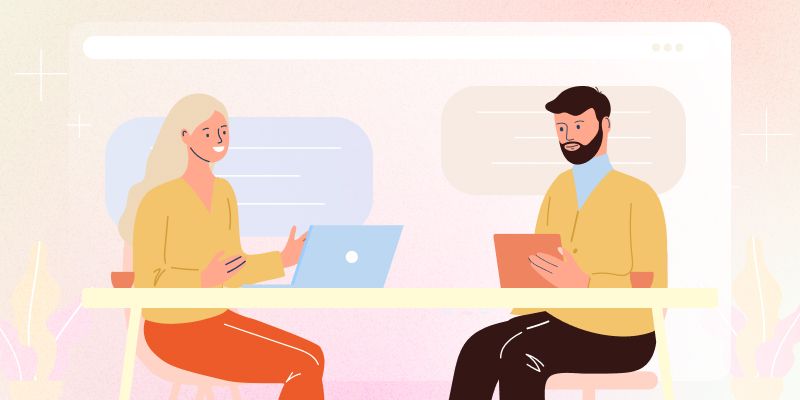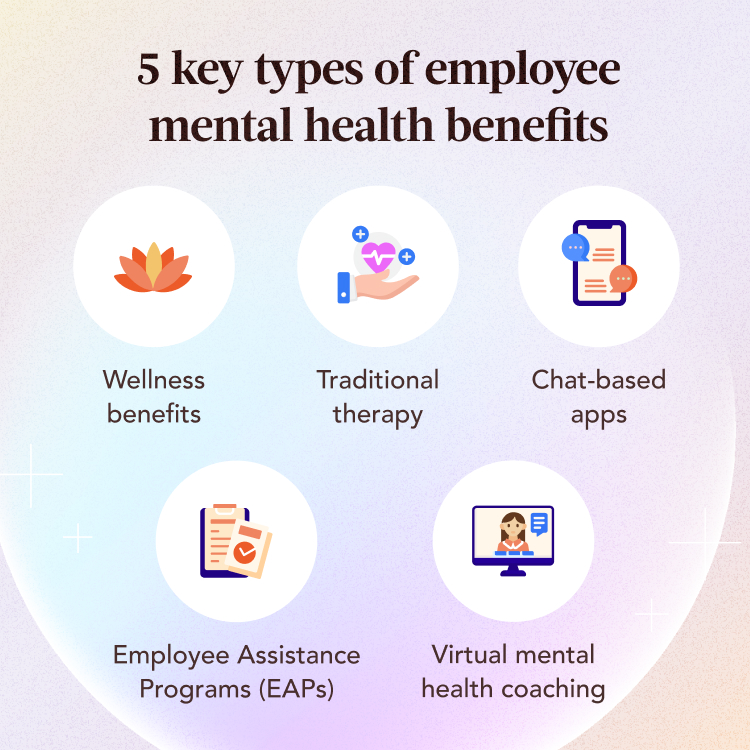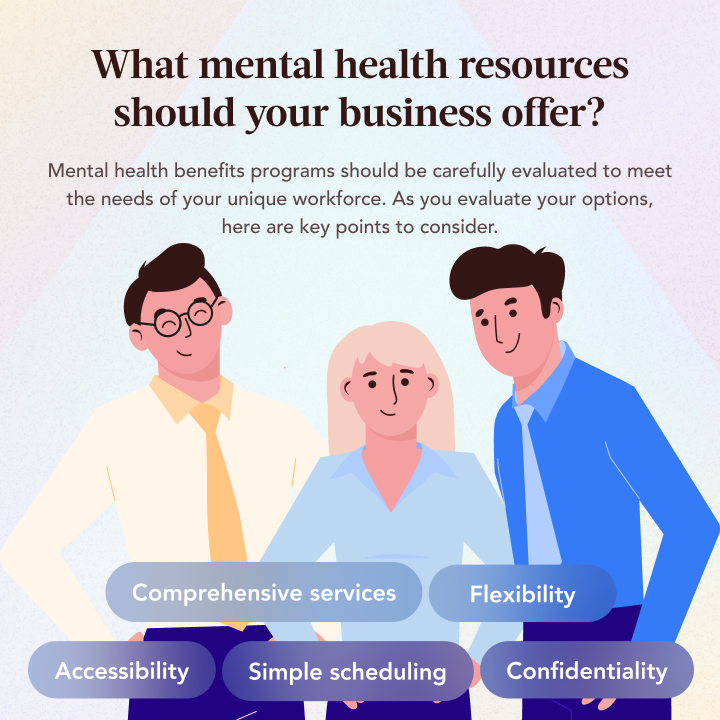What Are Employee Mental Health Benefits?

Mental health conditions are increasingly common among adults in the US workforce. According to the National Institute of Mental Health, an estimated 51.5 million adults in the US experienced mental illness during 2020—that equates to about 21% of the adult population.
Yet these figures may not capture the full scope of workplace mental health concerns that employees experience. While burnout is typically not included in mental health statistics, a separate study by Harvard Business Review found that the psychological and physical toll of employee burnout causes $125 billion in healthcare spending per year.
To address these challenges, mental health benefits are becoming a key concern for both employees and employers. These benefits can take many forms—including counseling services, mental health days, and Employee Assistance Programs (EAPs)—and may be more or less structured depending on the benefit.
Studies have shown that mental health employer benefits can be very effective in improving employee mental health and well-being. A study by the American Psychological Association found that employees who received mental health benefits reported higher job satisfaction and were more likely to stay with their employer.
Mental health employer benefits have also been shown to improve business outcomes. For example, a study by the World Economic Forum found that for every $1 invested in mental health programs, businesses saw a return of $4 in improved health and productivity. An additional study by Deloitte found that companies that prioritize mental health have higher employee engagement, increased productivity, and reduced absenteeism and turnover rates.
In this blog post, we will explore the range of mental health employer benefits, including the different types of benefits, the pros and cons of offering these programs, and tips for implementing an effective employee mental health benefits program in your organization.
What are the different types of employee mental health benefits?
There are a wide range of programs and resources businesses may choose to provide in order to support employee mental health and wellbeing. The optimal benefits for your workplace and employee needs may be different than other organizations. This overview will introduce you to the scope of what’s available, and guide you toward the options that may work best for your workplace environment and business goals. Let’s dive in.

5 key types of mental health employer benefits:
1) Wellness benefits
Wellness benefits and programs refer to a broad range of initiatives organizations can implement in order to promote the physical and mental wellbeing of their employees. These might include activities and resources such as fitness classes, stress reduction programs, nutrition education, and mental health-related content.
Other examples could include on-site gyms, fitness classes, healthy eating initiatives, and mindfulness meditation sessions. Wellness benefits are designed to support employees' overall health and wellbeing, manage stress, and respond to challenges with enhanced coping skills.
2) Traditional therapy
Employee mental health benefits may in some cases cover traditional therapy services as part of the organization’s health insurance plan, or as a separate benefit. Traditional mental health services that are offered through medical insurance may include therapy services, such as counseling or psychiatric services.
However, the extent of this coverage can vary, and may be very limited, depending on the employer and the specific insurance benefits package offered. In some cases, employees may need to pay out of pocket in part or in full for therapy services, or may be limited in the number of sessions they can receive.
3) Employee Assistance Programs (EAPs)
Employee Assistance Programs (EAPs) refer to a wide range of benefit programs that help employees address concerns such as mental health conditions, stress, addiction, grief, and even financial or housing issues. The number of companies offering EAPs varies widely, depending on the size of the business, industry, and region the business operates in.
While most larger businesses offer EAPs to their employees, utilization tends to be low. Multiple studies have found that fewer than 10% of employees take advantage of them in a given year, and many employees often do not even know their company offers an EAP.
EAPs can lead to improved outcomes for both businesses and employees, but there are drawbacks to the structure of some programs which businesses should be aware of. EAP benefits may be hard for employees to access, employees may not trust that EAP programs are confidential, and the stigma around mental health may make employees hesitant to reach out for help.
Further, many EAP programs offer a strictly limited number of counseling sessions before employees are referred to outside services. While EAPs can be a beneficial resource, employers should research the benefit structure, accessibility, and outreach to ensure a good fit for employee needs.
4) Chat-based apps
Chat-based apps are becoming more popular as a way for employers to provide employees with mental health benefits. These apps offer a variety of resources and support, from text and video therapy sessions to AI-powered coaching and support. They're convenient, accessible, and provide a confidential way for employees to access mental health resources.
At the same time, there are also some drawbacks to chat-based apps. They are most likely not suitable for individuals with more significant or complex issues, and should not be considered a replacement for mental health services and treatment. Additionally, some employees may be uncomfortable with using technology for mental health support, or may simply prefer face-to-face modalities.
5) Virtual mental health coaching
Virtual mental health coaching can be a valuable element in employee mental health benefit programs. This type of coaching offers personalized support and guidance that guides employees to effectively manage stress, anxiety, and other mental health issues.
Virtual coaching sessions can be conducted online, by phone, or via video conferencing, providing flexibility, ease, and convenience for employees. This type of coaching can also be more affordable than traditional therapy and may offer greater access and inclusivity, especially for employees who live in remote areas, have limited transportation options, or seek greater flexibility in scheduling.

What employee mental health resources should your business offer?
Mental health benefits programs should be carefully evaluated to meet the needs of your unique workforce. Accessibility continues to be a significant barrier to effectively get benefits to employees, so employers should search for benefit access that is flexible, with options such as video, audio, chat or asynchronous messaging available based on the patient's comfort level. And these solutions should be accessible for scheduling outside business hours, with minimal wait times.
It's important for companies to educate employees about available benefits, promote a safe and supportive work environment, and work to reduce the stigma around mental health care in the workplace. By taking these steps, businesses can help create a positive work culture that truly values the mental health and well-being of each employee.
Altogether, mental health benefits can help to reduce stress, prevent burnout, and improve overall job satisfaction. When these programs are applied effectively, they can lead to increased fulfillment, productivity, retention rates, and many more positive outcomes for all.
How Frankly can help
Frankly's EAP solution delivers an innovative suite of mental health and wellness benefits that boost both employees and employers. Our program offers a comprehensive range of mental health services, including virtual mental health coaching, therapy, psychiatry, and on-demand content, which employees can access directly and flexibly. Frankly’s proactive approach to engagement meets employees where they are at, and delivers the personalized services that best fit for them, leading to increased program utilization. To learn more, book a 15-minute demo with us today.
